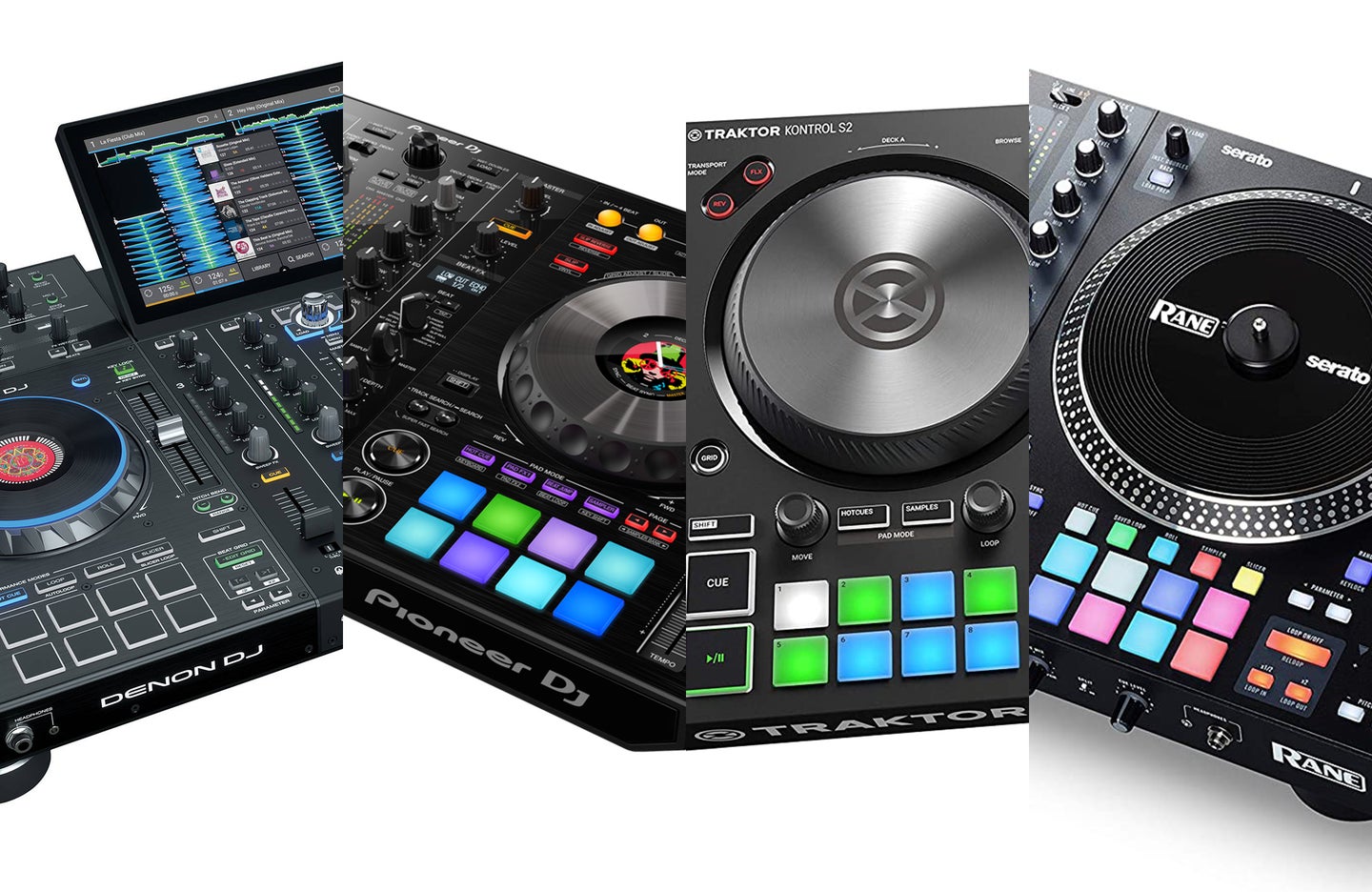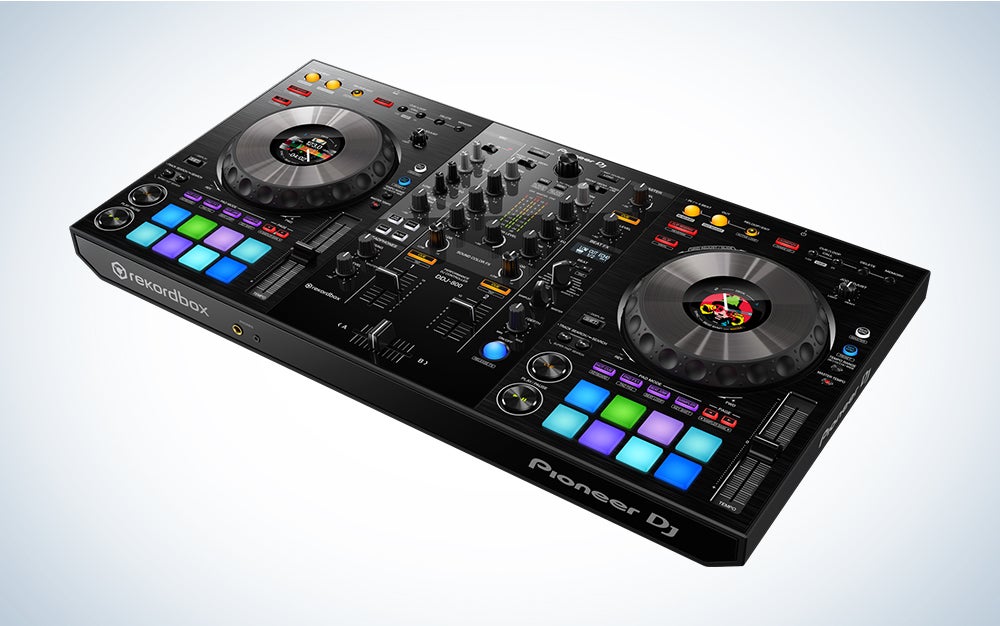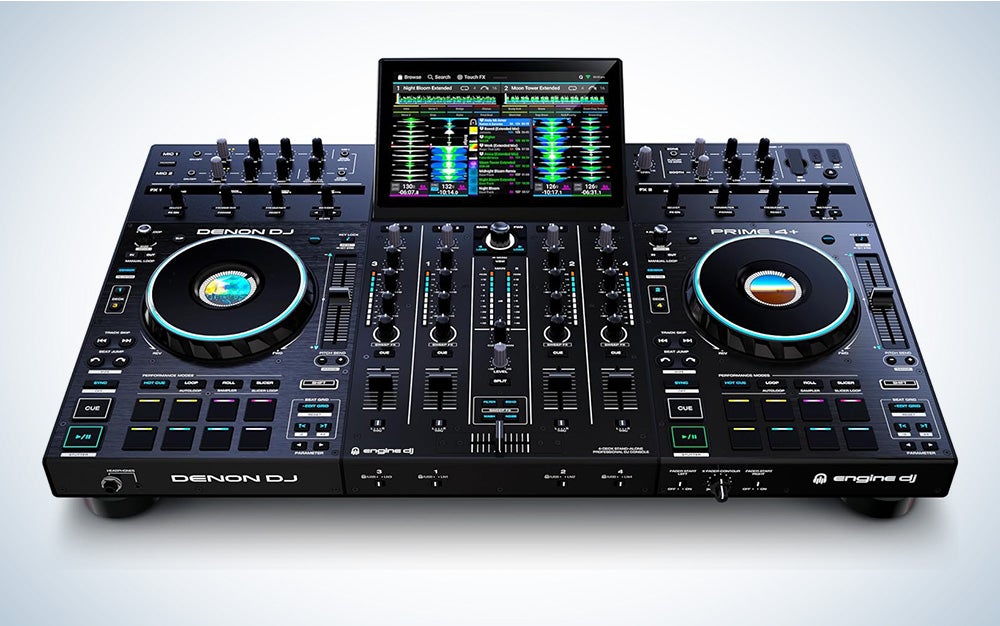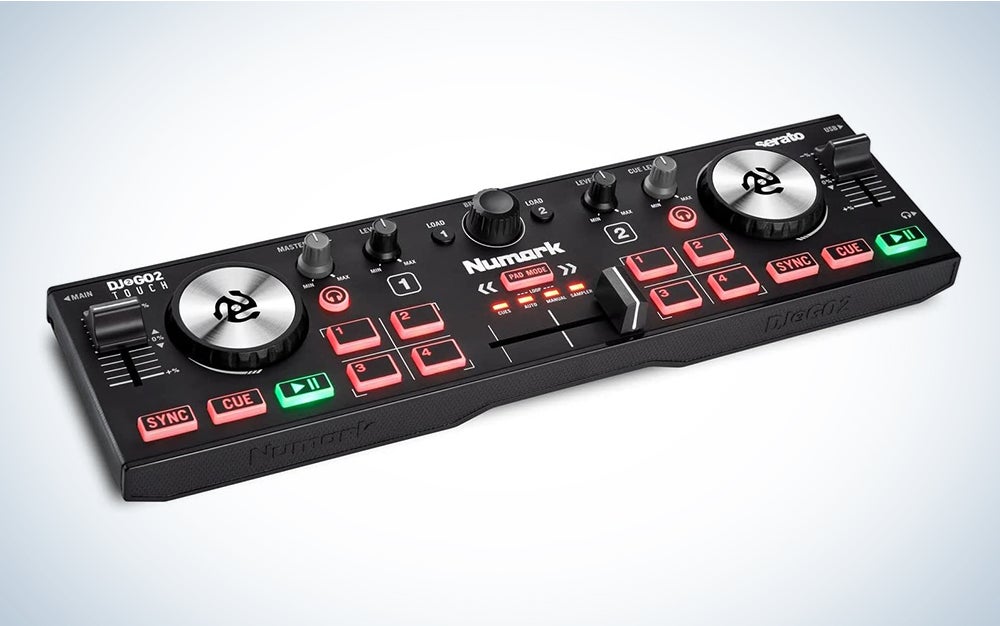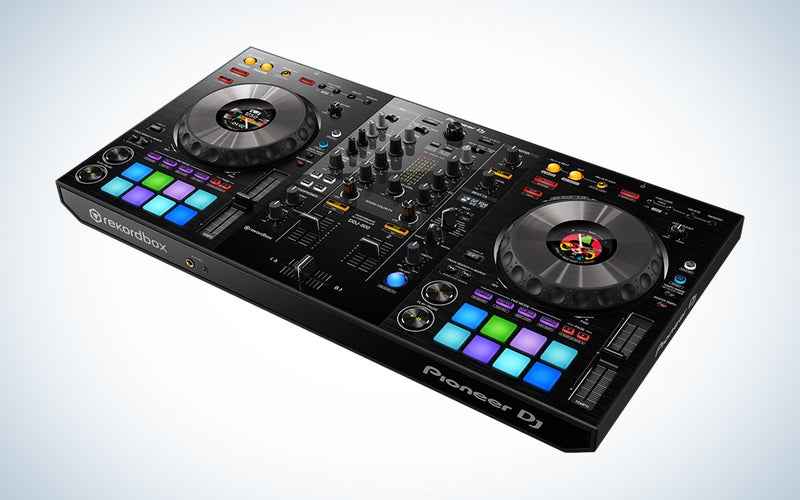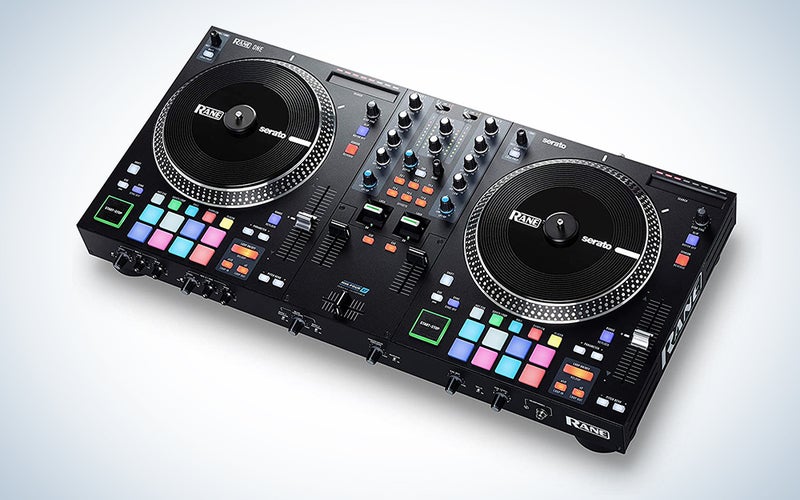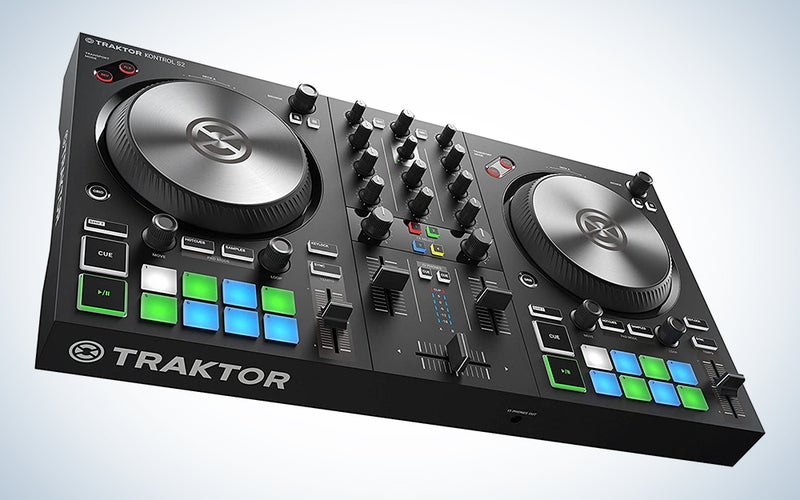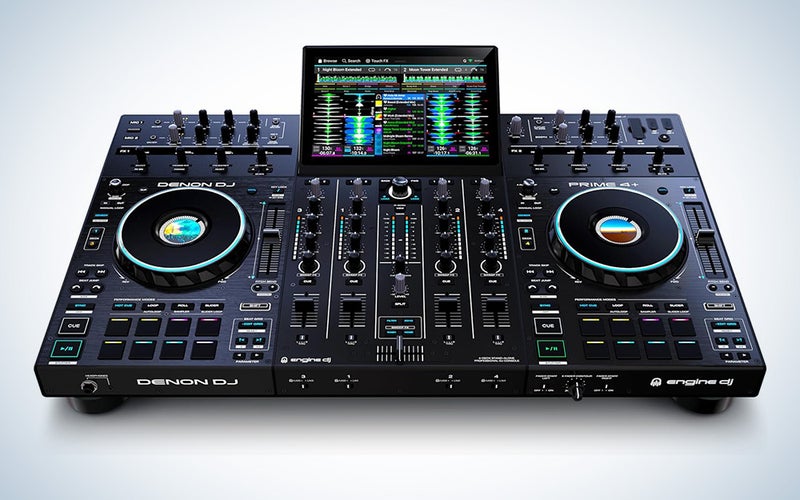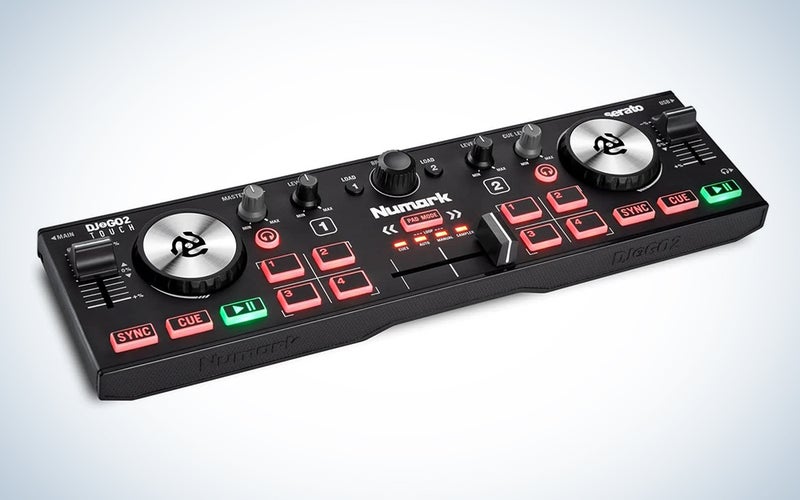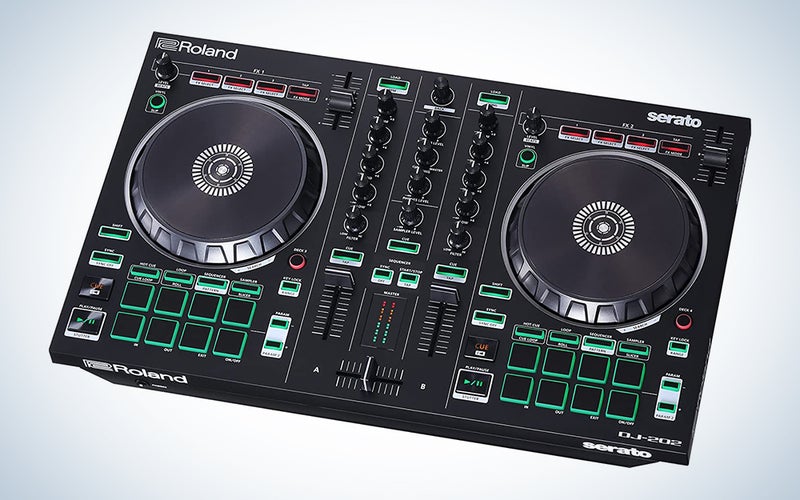We may earn revenue from the products available on this page and participate in affiliate programs. Learn more ›
DJ controllers leverage the processing power and massive storage of laptops—and sometimes mobile devices and cloud services—so that DJs can spin sets from enormous music libraries at a fraction of the cost and hassle of using high-end DJ turntables, mixers, and media players. While DJ controllers cover a wide range of sizes, feature sets, software compatibility, and prices, they generally connect to host devices over USB and include audio outputs for sending your mix to a main set of speakers and your cued music to headphones. Some DJ controllers prefer standalone systems that allow self-contained mixing but can also connect to a computer when you want to see a larger screen and potentially access additional software capabilities. For both complete newbies and old-school turntablists, this handy hardware can unlock a new world of possibilities, making DJing more creative and even more fun. Choosing the right one for you is where that fun begins, so let’s get into the best DJ controllers of 2023.
- Best overall: Pioneer DJ DDJ-800
- Best for scratching: Rane One
- Best for beginners: Native Instruments Traktor Kontrol S2 MK3
- Best standalone system: Denon DJ Prime 4+
- Best compact controller: Numark DJ2GO2 Touch
- Best budget: Roland DJ-202
How we chose the best DJ controllers
I have been a performing DJ for more than 15 years and have covered DJ gear (such as the Pioneer DJ XDJ-RX3) for DJ Tech Tools, Electronic Musician, Remix, Popular Science, and other outlets. I’ve personally used half of the DJ controllers on this list for public DJ sets, livestreams, or extensive reviews, and the remaining choices are based on thorough research, the feedback of fellow DJs, and other expert reviews. This guide includes the best DJ controllers for a variety of needs, skill levels, and price points.
The best DJ controllers: Reviews & Recommendations
Finding the perfect DJ controller may not spike your dopamine as much as laying down a perfect set for a hyped crowd, but it should be an enjoyable process. And it’s better to start spinning tracks rather than spin into a spiral of indecision, which is where our list comes in. There are many great options, and unless you want to invest in more than one for different situations, you may end up sacrificing some great features for portability or vice versa. Or you may find the exact controller you want, but it doesn’t work with your preferred software. To make your search easier, here are our picks for the best DJ controllers available this year for many different situations and budgets.
Best overall: Pioneer DJ DDJ-800
Pioneer DJ
Why it made the cut: Gig-ready gear that comes the closest to mimicking the layout and workflow of Pioneer DJ’s club-standard media players and mixers in a 2-channel controller.
Specs
- Channels: 2 decks plus mic input channel
- Inputs and Outputs: XLR and RCA stereo Master outputs; balanced ¼-inch stereo Booth output; ¼-inch and 1/8-inch stereo headphone outputs; two stereo RCA phono/line channel inputs; stereo RCA Aux input; one balanced XLR/1/4-inch combo Mic input; one balanced ¼-inch Mic input.
- Audio Resolution: 24-bit/44.1kHz
- Software Native Compatibility: Pioneer Rekordbox
Pros
- Has the layout and feel of Pioneer DJ’s high-end club gear in a smaller, more affordable package
- Informative on-jog color displays
- Unlocks a performance-ready version of Rekordbox DJ software
- Excellent performance pad modes
Cons
- High-level Rekordbox functions like DVS and cloud storage/syncing require a subscription
The Pioneer DJ DDJ-800 recreates the layout and features of Pioneer DJ’s professional club-standard CDJ-NXS2 media players and DJM mixers but in a single unit for controlling the company’s Rekordbox software. It also unlocks a performance-ready version of Rekordbox so that you don’t have to pay for a subscription to the software, unless you want to unlock extra features like the DVS (digital vinyl system) Plus Pack, or other subscription levels for music library cloud storage and syncing. The DDJ-800 gives you basically everything from the popular 4-channel DDJ-1000 except in a smaller, 2-channel version that weighs about 1.3kg less and costs about $400 less.
Color LCD displays in the center of the jog wheels help you see the essential track information without staring at the computer screen, and you can customize them to show what you want to see, including BPM, cue and loop points, and the waveform with playback position. Another small display dedicated to the popular Beat FX from Pioneer’s DJM mixers shows the settings. If you scratch while DJing, the jog wheel’s resistance is also adjustable to your preference. The DDJ-800’s mixer has two stereo phono/line audio inputs, so you can use the controller’s channel faders, trims, and EQs for external turntables and media players, as well as using Rekordbox’s effects on the external sources.
The 16 performance pads (eight per deck) control several pads modes: Hot Cues, Pad FX, Beat Jump, Sampler, Keyboard Mode, Beat Loop, and Key Shift, which can automatically change the key of the upcoming track to match the master deck or shifts the keys up or down to your liking. With the pad Page function, you access 16 Hot Cues per deck and toggle the pads to control cues 1-8 and 9-16.
Best for scratching: Rane One
Rane
Why it made the cut: A controller that caters to scratch DJs with the dual motorized, vinyl-feel platters and pro-level crossfader on the Rane One.
Specs
- Channels: 2 decks plus 2 mic inputs
- Inputs and Outputs: RCA stereo Master output; balanced XLR stereo Main output; balanced XLR stereo Booth output; ¼-inch and 1/8-inch stereo headphone outputs; two stereo RCA phono/line channel inputs; stereo RCA Aux input; two balanced XLR/1/4-inch combo Mic inputs
- Audio Resolution: 24-bit, 48kHz
- Software Native Compatibility: Serato DJ Pro, Aloriddim Djay Pro AI, VirtualDJ
Pros
- Dual 7-inch motorized turntable-style platters with real vinyl feel
- Pro scratch DJ Mag Four crossfader with tension and contour adjustment
- Two USB ports for seamless transition between two laptops
- 16 multi-function performance pads that support Serato DJ Pro’s Scratch Bank mode
Cons
- You must pay a price for this kind of quality
- Serato DJ Pro license not included
Among DJ-focused brands, Rane has carved out a niche as one of the most trusted and beloved names that concentrate on the needs of scratch DJs. The company makes some of the best scratch DJ mixers (such as the Seventy-Two MKII), and now it has laid claim to some of the best DJ controllers for scratching. While you can scratch with most DJ controllers with jog wheels, dedicated scratch DJs most often prefer to use vinyl turntables to scratch, because that’s where they have the most control and the best feel to practice their art form. However, with the Rane One, scratch DJs don’t have to sacrifice much to use a DJ controller. It provides the feel of two turntables with a scratch mixer along with conveniences like a dedicated loop section, track browsing and loading, and eight multi-function performance pads on each deck. The two motorized 7-inch turntable platters have the feel of real vinyl, including vinyl brake speed adjustment, and the buttery smooth, professional scratch DJ Mag Four crossfader equals those of high-end scratch mixers, including tension and contour adjustment.
Rane One’s mixer section has six FX buttons for calling up effects combinations within the DJ software, and the aluminum FX paddles give scratch DJs the effects control they crave—the ability to lock the effects on or to momentarily toggle the effects on with the paddle down. For the pure feel of a full-size turntable in a DJ controller, Rane also makes the Twelve MKII, which works like a full-size, vertically oriented, 12-inch motorized turntable controller for DVS-enabled Serato DJ Pro, Traktor, and VirtualDJ. However, for scratch DJs who want the best of both the DJ controller and vinyl-manipulation worlds in a single unit that—at about 27 by 14 inches—is much smaller than two turntables and a mixer, nothing beats the Rane One.
Best for beginners: Native Instruments Traktor Kontrol S2 MK3
Native Instruments
Why it made the cut: This compact, beginner-friendly DJ controller works in lock-step with Native Instruments software and won’t be obsolete when you progress from beginner status.
Specs
- Channels: 2 decks plus mic input
- Inputs and Outputs: Stereo RCA and stereo 1/8-inch main outputs; 1/8-inch stereo headphone output; ¼-inch mic input
- Audio Resolution: 24-bit/44.1kHz or 48kHz (selectable in software)
- Software Native Compatibility: Traktor DJ 2 (free download), Traktor Pro 3 (license included)
Pros
- Approachable feature set with lasting appeal to higher skill levels
- Very high-quality build and audio
- Dedicated USB port for iPad connectivity
- Includes Traktor Pro 3 license
Cons
- No controls for Traktor Pro’s effects decks
- Smaller than full-size performance pads
- Fewer performance pad modes than many DJ controllers
There are many DJ controllers aimed at beginners. But if your goal is to not remain an entry-level entertainer forever, the Native Instruments Traktor Kontrol S2 MK3 lets you start out with a manageable piece of hardware that semi-pro and pro-level DJs will still use when a gig calls for a relatively small DJ controller. Even better, beginners can start out with the free Traktor DJ 2 software (available for Mac, Windows, and iPad), which is very approachable to beginners yet still has the core features you need for credible DJ sets. Traktor DJ 2 is also one of the best DJing apps for iPad and the S2 MK3 includes a dedicated USB port for iDevice connections. When you’re ready to graduate from Traktor DJ 2, you can step up to Traktor Pro 3, which is included with the S2 MK3. Traktor Pro 3 now also has a Pro Plus subscription for added performance features like a drum pattern sequencer, but it’s not necessary to subscribe to use the main Traktor Pro 3 software.
Aside from its manageable size (about 19.1 by 10.4 inches) and flexible software options, the S2 MK3 puts a decent amount of controls at your fingertips for a small controller. There are 16 total performance pads for triggering saved cue and loop points; multi-purpose touch-sensitive jog wheels for searching waveforms, nudging playback, and scratching; and four Mixer FX on each deck: filter, reverb, delay, and flanger. It even supports four-deck operation in Traktor Pro 3. While the Traktor Kontrol S2 MK3 treats beginners well, it also gives them room to grow into seasoned DJs.
Best standalone system: Denon DJ Prime 4+
Denon
Why it made the cut: Compared to other standalone DJ systems, this setup does not hold back any functionality and offers the best touchscreen, connectivity, and overall feature set in its class.
Specs
- Channels: 4 decks plus two mic inputs
- Inputs and Outputs: RCA stereo Master output; three balanced XLR stereo outputs; ¼-inch and 1/8-inch stereo headphone outputs; two stereo RCA phono/line channel inputs two stereo RCA line channel inputs; two balanced XLR/1/4-inch combo Mic inputs; four USB media inputs; SD memory card slot
- Audio Resolution: 24-bit/44.1kHz
- Software Native Compatibility: Serato DJ Pro, VirtualDJ
Pros
- Brilliant 10.1-inch color touchscreen with gesture control
- Plenty of wired and wireless connectivity options
- Built for both standalone and laptop use
- Good value for what’s included
Cons
- Rather large and unwieldy for transporting
Pioneer DJ standalone DJ systems like the XDJ-RX3 are home-setup mainstays, in part because you can use the same Rekordbox-prepared USB sticks from the standalone system on club gear like the CDJ-3000. However, the Denon DJ Prime 4+ unequivocally packs the most features into its 4-deck frame at similar price to its main competitors (a little over $2,000). On first glance of the Prime 4+, the eye goes immediately to its brilliant 10.1-inch touchscreen, which offers gesture control familiar to mobile device users powered by the system’s multi-core processing. You can play music files without the use of a laptop thanks to four USB inputs and an SD card slot (as well as a built-in 2.5-inch SATA drive bay, if you add a hard drive/SSD), taking advantage of on-board song analysis. Or hook it up to a computer loaded with Serato DJ Pro or VirtualDJ software. The Prime 4+ also has built-in WiFi and an Ethernet port for accessing music from your personal Dropbox collection or from multiple streaming services: Amazon Music Unlimited, Tidal, SoundCloud Go+, Beatport Link, Beatsource Link, and Dropbox (subscriptions required).
The multi-view touchscreen can clearly show large scrolling waveforms for all four decks at once either horizontally or vertically, allows fast and easy track browsing and loading, lets you create playlists on the fly, and dynamically shows the relevant parameters as you play, such as looping, beat slicing, track roll, and other performance pad modes.
A generous effects control section on each side includes its own mini displays for showing the parameters of the 26 dynamic internal DJ effects, in addition to the per-channel Sweep FX knobs (combinable with Main FX). There’s an embedded Sampler with 16 pad-triggered sample slots, volume control, and output routing, as well as standalone Stems functionality for real-time vocal and instrument isolation. You also get full hands-on control over the two mic inputs and multiple audio outputs.
To add visual elements to your DJ sets, the Prime 4+ integrates with SoundSwitch for customized or automated light shows, and Resolume for live visuals and videos. All told, the Prime 4+ impresses like no other standalone DJ system to date.
Best compact controller: Numark DJ2GO2 Touch
Numark
Why it made the cut: Simple, straightforward, and very small, this controller includes core DJing necessities that can slip easily into a slim laptop case.
Specs
- Channels: 2 decks plus mic input
- Inputs and Outputs: 1/8-inch stereo main output; 1/8-inch stereo headphone output
- Audio Resolution: 16-bit/44.1kHz
- Software Native Compatibility: Serato DJ Lite (included), Serato DJ Pro, VirtualDJ, Algoriddim Djay for iOS
Pros
- Extremely compact for easy portability
- Four pad modes
- Touch-sensitive jog wheels allow both scratching and nudging
- Low price
Cons
- No track EQ controls
For an ultra-compact DJ controller weighing only 12 ounces and measuring 12.4 by 3.4 inches, the Numark DJ2GO2 Touch dishes out a surprising amount of controls and functionality. There are many reasons to have such a tiny DJ controller, including the ability to take a mini-rig almost anywhere to casually play from either a laptop or an iOS device. But the DJ2GO2 Touch can suffice even for more professional mobile DJing or gigs where a larger controller is either impractical or unnecessary. This slim controller connects with an included mini-USB to USB cable and both monitor and headphone outputs. Each mini-deck includes playback controls, headphone cue controls, level, pitch fader, four trigger pads, and a jog wheel. The DJ2GO2 Touch jog wheels have been upgraded from the previous DJ2GO2 controller to be capacitive on the top to enable both scratching and track nudging from the jog wheel’s side. There are even four selectable pad modes: cue triggering, auto-looping, manual looping, and sample triggering.
When used with the included Serato DJ Lite, you can DJ with streaming music from SoundCloud and Tidal. Track library browsing and deck loading round out the DJ2GO2 Touch to make it a very attractive option either as a starter DJ controller or an alternate second controller for when small size matters.
Best budget: Roland DJ-202
Roland
Why it made the cut: This excellent 2-channel DJ controller stands out for its included Serato DJ Pro license for U.S. customers and some unique music production-oriented features.
Specs
- Channels: 2 decks plus mic input
- Inputs and Outputs: Stereo RCA main output; 1/4-inch stereo headphone output; ¼-inch mic input; MIDI output
- Audio Resolution: 24-bit/48kHz
- Software Native Compatibility: Serato DJ Lite, Serato DJ Pro (license for US customers only)
Pros
- Solid all-around 2-channel DJ controller with 4-deck support in Serato software
- Includes Serato DJ Pro license for US customers
- Built-in drum machine and MIDI out for syncing external gear
Cons
- May take some leg work to obtain the Serato DJ Pro upgrade
While the Roland DJ-202 measures up as a super-solid 2-channel controller for Serato software, it’s not the least expensive option out there. What makes it an irresistible prospect for serious DJs on a budget is its inclusion of an upgrade to Serato DJ Pro (for U.S. customers only). You may have to jump through some hoops with customer service to get the Serato DJ Pro license, but DJ-202 buyers are still getting it in 2023.
Either way, the DJ-202 is packed with features for its size. Two effects sections give you full control over Serato’s internal audio effects, and the mic input has onboard reverb and echo. Its eight performance pads per side support eight pad modes, including one that lets you use the 16 total pads together to sequence drum beats using the famous sounds of Roland’s classic drum machines: the TR-909, TR-808, TR-707, and TR-606. A MIDI output also lets you sync the DJ-202 tempo from the software to external MIDI gear like samplers, synthesizers, or drum machines—a rarity for a DJ controller.
Things to consider before buying the best DJ controllers
Some specialty DJ controllers do not include audio interfaces that let you monitor the cue mix in your headphones and send audio out to the main speakers. This guide only spotlights DJ controllers that include audio interfaces and also access to some level of mixing software, so you can get started DJing right away. The audio capabilities of the controllers on this list vary. Some of them have basic audio connections, so you can only plug in your headphones and one set of main monitors. Others have much more, including audio inputs for turntables and DJ media players, separate booth monitor outputs, and microphone inputs.
DJ software
Many DJs prefer to decide which DJ software they want to use before picking their DJ controller, as this narrows down DJ controllers to the ones that support the software out of the box. Some DJ software, like Virtual DJ and Algoriddim DJ, supports many controllers with mappings that the software developers have made, but you won’t find many DJ controllers made specifically for those programs. Other DJ software, like Pioneer DJ Rekordbox and Native Instruments Traktor Pro, has a limited number of natively support DJ controllers made by the same maker of the software. Serato DJ has the largest selection of third-party DJ controllers that are made specifically for that software. Traktor Pro and some other DJ software options also have MIDI mapping built-in, so any DJ controller could be made to work with them. However, most DJs do not want to go through the trouble of creating their own MIDI mapping, and the user-made mappings available online are hit or miss.
Size
For the most part, the more mixer channels and features (such as FX controls, displays, and performance pads) that a DJ controller has, the larger its footprint. They can be made smaller by making the jog wheels, performance pads, pitch faders, or other elements more compact but, eventually, DJ controllers that are more and more streamlined will have to sacrifice some features. The size of the controller could matter for a multitude of reasons. If you’ll be using it to perform, your venue may be limited in the amount of space it has for your controller, or you may not want to carry something beyond a certain size. There are some very large, heavy 4-channel DJ controllers and standalone DJ systems/controllers that are a joy to mix on but can be much tougher to take out for shows. Some DJs only use them for at-home practice and streaming.
Mixer channels and features
The number of mixer channels—two or four—distinguishes many DJ controllers. Certainly, many high-end two-channel DJ controllers exist but, conversely, there are not many entry-level controllers with four channels. Most four-channel controllers and some two-channel controllers have extra audio inputs to connect turntables and DJ media players to the controller’s mixer channels, while others may only have four channels for playing four decks of internal audio from the DJ software. Even if you do not plan on using more than two decks while DJing, it can be handy to have a four-deck controller because you can change the MIDI function of the extra channel-strip controls to assign them to other functions in the software that do not have dedicated hardware controls, like effects manipulation, turning quantization on/off, etc.
Control features
DJ controllers also vary significantly in how many/what type of features they include. If they are made for scratch DJs, for example, they will probably have a professional crossfader, like a Magvel, made for smooth and accurate precision over a long life of extended use. They will also probably have larger jog wheels made to better simulate the response of turntables, which may include motorized platters and a vinyl piece on top to respond like a record. On the other hand, occasional controllers, like the now-discontinued Native Instruments Traktor Kontrol S8, don’t have jog wheels at all, and others have much smaller jog wheels to save space.
Many other control features may play into your choice of DJ controller, like having performance pads and different pad modes, the availability and size of control sections for effect modules and looping, built-in displays, and features unique to specific controllers, like the drum machine abilities of the Roland DJ controllers. Knowing the kinds of controls available and the ones most important to you can help you make your decision, but remember that it can be tricky to find a DJ controller with the exact controls you want, at the right size, that works with the software you want, all within your acceptable price range.
Price
DJ controllers range widely in price from under $100 for some barebones yet highly portable gear to well over $2,000 for some of the largest, most deluxe pro controllers, some of which may also be standalone systems you can use without a laptop. While I recommend staying within your means, it’s also worth it to try to decide on a controller you really vibe with rather than compromising to save a few bucks. Quality DJing rests more on your musical choices and mixing skills than on the gear you use, but you should try to be as happy as you can be with your DJ controller. Frustration with your DJ gear can distract you from putting together a great DJ set.
FAQs
Q: Is Pioneer DDJ-SB3 good for beginners?
Yes, the Pioneer DJ DDJ-SB3 could be a good controller for beginners, because it is relatively simple in its layout and it’s not overly expensive for getting started. The DDJ-SB3 is also advanced enough that some pro and semi-pro DJs use it for gigs where a compact controller makes sense. There are other DJ controllers that are a little more oriented toward beginners than the DDJ-SB3, such as the Hercules DJ DJControl Inpulse 200 or the Pioneer DJ DDJ-200. There are many appropriate DJ controllers for beginners. In this roundup, I have chosen the Native Instruments Traktor Kontrol S2 MK3 as the best DJ controller for beginners, because like the DDJ-SB3, it is compact, not too expensive, and straightforward in its control system yet advanced enough for professional use. What makes it excellent for beginners though is its lockstep compatibility with the free Traktor DJ 2 software for Mac, Windows, and iPad, which is very approachable to beginners but still includes most of the core features needed to put together credible DJ sets.
Q: What is better, Serato or Rekordbox?
There are some things about each program that could make a person decide that Serato or Rekordbox is the better DJ software. Pioneer DJ Rekordbox has a vocal detection algorithm that shows you where there are vocals in the waveform, which is very helpful for not mixing competing vocals together between two tracks. Rekordbox is also a great option if you’re going to DJ from USB sticks on Pioneer DJ CDJ media players at a club because Rekordbox will let you practice and prepare tracks at home on your computer and then perform in public from your music library on a USB drive. With Serato DJ Pro, you have more supported DJ controller options to choose from, as well as better software pricing options that don’t force you into a subscription. Serato DJ is often considered the best DJ software for hip-hop music and scratching, but it will work fine for any style of music.
There really is no 100% objective answer to which of the top two DJ software programs is better. You can certainly be the best DJ you can be using either program, but choosing between the two will come down to personal choice.
Q: Can you use a DJ controller without a laptop?
Yes, you can use a select group of DJ controllers without a laptop. They are often referred to as standalone DJ systems because they work like other DJ controllers but have their own screens and don’t need a laptop connected. You can also use them with a laptop and their compatible software programs if desired. These standalone systems are often hefty and rather expensive, like the Denon DJ Prime 4+ recommended here or the Pioneer DJ XDJ-RX3. There are also smaller and less expensive options like the $699 Numark Mixstream Pro.
Q: Is Virtual DJ compatible with Pioneer?
Virtual DJ is compatible with most major Pioneer DJ controllers, from the more entry-level controllers like the Pioneer DJ DDJ-400 all the way up to Pioneer DJ’s flagship CDJ-3000 media players. The Virtual DJ software in fact has the most comprehensive support for DJ hardware in general, with native compatibility for 300+ DJ controllers, mixers, and all-in-one systems. It may not be compatible with every DJ controller Pioneer DJ has ever made, but it does cover most of the bases.
Final thoughts on the best DJ controllers
- Best overall: Pioneer DJ DDJ-800
- Best for scratching: Rane One
- Best for beginners: Native Instruments Traktor Kontrol S2 MK3
- Best standalone system: Denon DJ Prime 4+
- Best compact controller: Numark DJ2GO2 Touch
- Best budget: Roland DJ-202
Several key factors play into your decision on the best DJ controller to buy: software compatibility, size, price, number of mixer channels, and the availability of performance features like pad modes and effects sections. It can be a challenge to find one that fits the exact profile you want but parse through our picks, and you will soon be equipped with the perfect DJ booth companion.
Why trust us
Popular Science started writing about technology more than 150 years ago. There was no such thing as “gadget writing” when we published our first issue in 1872, but if there was, our mission to demystify the world of innovation for everyday readers means we would have been all over it. Here in the present, PopSci is fully committed to helping readers navigate the increasingly intimidating array of devices on the market right now.
Our writers and editors have combined decades of experience covering and reviewing consumer electronics. We each have our own obsessive specialties—from high-end audio to video games to cameras and beyond—but when we’re reviewing devices outside of our immediate wheelhouses, we do our best to seek out trustworthy voices and opinions to help guide people to the very best recommendations. We know we don’t know everything, but we’re excited to live through the analysis paralysis that internet shopping can spur so readers don’t have to.
